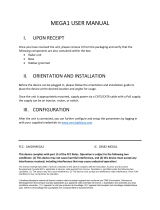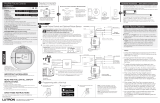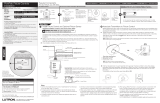Daintree GE Lumination LSA Series Guide d'installation
- Taper
- Guide d'installation

Lumination
TM
Sensor Accessory
LSA Series Installation
Installation Guide
IND541
BEFORE YOU BEGIN
Read these instructions completely and carefully.
Save these instructions for future use.
WARNING/AVERTISSEMENT
RISK OF FIRE OR ELECTRIC SHOCK
• Turn power off before inspection, installation or removal.
• Follow all NEC and local codes.
• Do not make or alter any open holes in an enclosure of wiring or
electrical components during kit installation.
• Wear safety glasses and proper aid during installation and
maintenance.
• Install this kit only in the luminaires that has the construction
features and dimensions shown in the photographs and/or
drawings.
• Above ceiling access required.
• While the sensor is designed to withstand Electrostatic Discharge
(ESD), it is always advisable to touch a grounded metal object
before handling the sensor, particularly in an operating fixture.
RISQUES D’INCENDIE OU DE DÉCHARGES ÉLECTRIQUES
• Coupez l’alimentation avant d’’inspecter, installer ou déplacer le luminaire.
• Respectez tous les codes NEC et codes locaux.
• Ne pas percer ou altérer les trous d’un boitier contenant filou
composanélectriqu durant l’installation.
• Porter des lunettes de sécurité et les aides appropriéeslors de l’installation
et de l’entretien.
• Installez ce kit uniquement dans les appareils d’éclairagequi a les
caractéristiques de la construction et les dimensions indiquées dans les
photographies et/ou dessins.
• Accès requis au-dessus du plafond.
• Bien que le capteur soit conçu pour résister aux décharges électrostatiques
(ESD), il est toujours conseillé de toucher un objet métallique mis à la terre
avant de manipuler le capteur, en particulier dans une installation en
fonctionnement.
Specifications
Description Code for Sensor Accessory
Save These Instructions
These instructions do not purport to cover all details or variations in components nor to provide for every possible contingency to be
met in connection with installation, operation or maintenance. Should further information be desired or should particular problem arise
which are not covered sufficiently for the purchaser's purpose, the matter should be referred to General Electric Company. Current,
powered by GE does not claim liability for any installation not performed according to a this guide or not by a qualified electrician.
Prepare Electrical Wiring
Electrical Requirements
• The LED luminaire must be connected to the mains
supply according to its ratings on the product label.
Grounding Instructions
• The grounding and bonding of the overall system
shall be done in accordance with National Electric
Code (NEC) Article 600 and local codes.
T1 (WIT100 Sensor) - Daintree One (120-277 VAC)
TT (WIT100 Sensor) - Daintree EZ Connect (120-277 VAC)
TZ (WIZ100 Sensor) - Daintree Enterprise (120-277 VAC)
TM (WMZ10 Sensor) - Daintree Enterprise Multi-Sensor
(120-277 VAC)
CONTACT FACTORY for details and limitations when seeking to add this device to a luminaire being used with an emergency system other
than Battery Backup.

COMPONENTS SUPPLIED AND IDENTIFICATION
NOTE:
• All cables are CMP (Plenum) rated.
• Identification sticker labels are to be placed on or near luminaire and on a floor plan for mapping
WIT100
• T1 - Daintree One Sensor
OR
• TT - D
aintree EZ Connect
Sensor
• CMP Cable
• Identification sticker labels
WIZ100
• TZ - Daintree Enterprise
Sensor
• CMP Cable
• Identification sticker labels
WMZ10
• TM - Daintree Enterprise
Multi-Sensor
• CMP Cable
• Identification sticker labels
OPTION A - NON ENCLOSED SENSOR INSTALLATION
SENSOR ACCESSORY INSTALLATION WITH GE CURRENT LED FIXTURE (SQ OPTION)
DISCONNECT POWER
INSTALL SENSOR UNIT DIRECTLY
INTO CEILING
1 2
Disconnect incoming power to the fixture at the
panel
Hole in ceiling – up
to installer on
where to place the
hole next to
luminaire
Mounting Option – Using ONLY CMP
(Plenum) Rated Cable
Make a hole in ceiling where sensor is to be
mounted. It is recommended that the diameter of
the hole be slightly smaller than the outer
diameter of the sensor body. The recommended
diameter of the hole should be approximately
5/8” or 16mm. The sensor should be wedged into
softer (e.g. drywall or ceiling tile) material for
extra grip. The sensor will have either snap arms
or a nut to fasten to ceiling.
2

CONNECT SUPPLIED
SENSOR CABLE
ROUTE SENSOR CABLE OUT OF
FIXTURE
3
4
AC Line
AC Line
Follow
appropriate
codes for type of
grommet to be
used.
Connect sensor cable to luminaire or accessory box.
If the sensor cable is not mounted on the knockout
plate, remove the knockout plate to access the
sensor cable. The luminaire or accessory box will
have a black and red cable with a male connector
located inside the electrical cavity. Remove a
knockout hole on the knockout plate. Follow
appropriate codes for type of grommet to be used
for the sensor cable to pass through the hole. NOTE:
The sensor cable connector may be mounted on the
outside of the knockout plate. In this case plug the
sensor cable in without removing knockout plate.
Route the sensor cable through the knockout hole
and/or bushing into luminaire and make the
connection. Fasten the knockout plate back to
luminaire. All work happens above ceiling. The
luminaire does not have to be removed.
LOCATE SENSOR LOCATION
INSTALL SENSOR IN CEILING
5
6
Depending on sensor mounting, route cable
through created hole in ceiling. Make sure sensor
is connected to the cable.
Installation is complete
3

OPTION B - ENCLOSED SENSOR INSTALLATION
SENSOR ACCESSORY INSTALLATION WITH GE CURRENT LED FIXTURE (SQ OPTION)
COMPONENTS REQUIRED CREATE HOLE IN CEILING
1 2
Materials to be supplied by
installer:
• Standard electrical enclosure
box (UL listed)
• Electrical conduit (UL listed)
Materials ordered separate
as an accessory from
Current:
• Cover plate and mounting
screws
Mounting Option – When conduit is required by
code
Make hole in ceiling to accommodate a standard
UL listed electrical enclosure compatible with
cover plate.
MOUNT ELECTRICAL BOX INSTALL SENSOR ON COVER
PLATE
3 4
Mount the electrical box to the ceiling following
appropriate codes.
Place sensor cable
into appropriate
sized electrical
conduit per code.
If sensor
connector does
not fit conduit
diameter, cut and
splice sensor cable
wires following
appropriate codes.
CONNECT SENSOR ATTACH COVER PLATE
5 6
Use supplied cover
plate and attach
sensor. Once
connected to cover
plate, connect the
sensor to the
sensor cable.
Use supplied screws to attach cover plate to
electrical box. Installation is complete.
4

OPTION C - SENSOR ACCESSORY INSTALLATION STANDALONE UNIT
(NO LED FIXTURE).
FOLLOW OPTION A OR B FOR NON ENCLOSED OR ENCLOSED INSTALLATION
DISCONNECT POWER VERIFY POWER SUPPLY AND
SENSOR ARE COMPATIBLE
1 2
Remove power by switching circuit breaker to the
off position.
+
COMPATIBLE
POWER SUPPLY
(WMZ10 only)
OR LCA KIT
=
MAKE ELECTRICAL
CONNECTIONS
CEILING INSTALLATION (SEE
OPTION A OR B)
3 4
Install the sensor unit into the ceiling following the
same steps as mentioned in Option A or B of this
installation guide.
120-277VAC
LINE
NEUT
DC+
DC-
DC+ (RED)
DC- (BLACK)
OPTION A
• Direct ceiling install
(CMP cable used)
OPTION B
• Metal box/conduit
install
To verify a compatible power supply, please refer to
the Power Supply Compatibility List table on the Multi-
Sensor (TM) spec sheet. Note: Connect TM sensor to GE
Lighting Solutions LLC LED drivers or control modules
not capable of providing greater than 15VA power,
including but not limited to models listed in Power
Supply Compatibility List.
Connect wires from the power supply or LCA Kit to the
sensor input wires. Connect the power supply input wires
to the appropriate power source. Use only U.L. approved
wire connectors for all electrical connections. Be sure to
insulate unused leads INDIVIDUALLY to 600Vrms using U.L.
approved wire connectors.
TM MULTI-SENSOR
ORIENTATION MARK
TM MULTI-SENSOR
ORIENTATION REQUIREMENT
5 6
For the WMZ10 TM Multi-Sensor there is an arrow on the
lens. This arrow is a mark or indicator for the direction of
the sensor.
When the sensor is installed, all sensors should face the
same direction. The arrow can be used to point all sensors
in one direction. As a reference all sensors installed should
have the arrow pointing North.
N
EW
S
5

SENSOR REPLACEMENT
IDENTIFY SENSOR MODEL INSTALLED
1
TZ (WIZ100)
T1/TT (WIT100)
TM (WMZ10)
REMOVE SENSOR FROM CEILING OR LED FIXTURE
2
FOR T1/TT & TM SENSORS
FOR TZ SENSOR
Grab sensor top as
indicated by arrows above
Gently pull sensor down
until connector is visible.
Disconnect sensor from
cable.
Leave cable available for
replacement sensor.
Depending on fixture type
or application, remove lens
or open fixture door with
sensor installed.
Disconnect sensor from
cable.
Remove nut from sensor. Sensor is removed.
6

INSTALL REPLACEMENT SENSOR
3
FOR T1/TT & TM SENSORS
FOR TZ SENSOR
Locate sensor cable.
Connect the sensor to the
sensor cable on fixture.
Orient the cable on the sensor
unit so it faces the end of the
fixture to prevent shadowing.
Push sensor in position until
it can no longer be pushed.
It will snap into position.
Attach replacement sensor
to lens or door depending
on application.
Push sensor through the hole
and use nut to secure. Make
sure the cable on the sensor
unit is facing the edge of the
lens to prevent shadowing.
Connect sensor unit to
cable on fixture.
Reinstall lens or door
depending on application.
NOTE:
• Identification sticker labels are to be placed on or near luminaire and on a floor plan for mapping
7

FOR STANDALONE SENSOR ACCESSORIES THE FOLLOWING STATEMENTS APPLY
Any changes or modifications not expressly approved by the party responsible for compliance could void the user’s authority to operate
this equipment. This device complies with part 15 of the FCC Rules. Operation is subject to the following two conditions: (1) This device
may not cause harmful interference, and (2) this device must accept any interference received, including interference that may cause
undesired operation. This device contains license-exempt transmitter(s)/receiver(s) that comply with Innovation, Science and Economic
Development Canada’s license-exempt RSS(s). Operation is subject to the following two conditions:
1. This device may not cause interference.
2. This device must accept any interference, including interference that may cause undesired operation of the device.
L’émetteur/récepteur exempt de licence contenu dans le présent appareil est conforme aux CNR d’Innovation, Sciences et
Développement économique Canada applicables aux appareils radio exempts de licence. L’exploitation est autorisée aux deux
conditions suivantes:
1. L’appareil ne doit pas produire de brouillage;
2. L’appareil doit accepter tout brouillage radioélectrique subi, même si le brouillage est susceptible d’en compromettre le
fonctionnement.
Note: This equipment has been tested and found to comply with the limits for a Class B digital device, pursuant to part 15 of the FCC
Rules. These limits are designed to provide reasonable protection against harmful interference in a residential installation. This
equipment generates, uses and can radiate radio frequency energy and, if not installed and used in accordance with the instructions,
may cause harmful interference to radio communications. However, there is no guarantee that interference will not occur in a particular
installation. If this equipment does cause harmful interference to radio or television reception, which can be determined by turning the
equipment off and on, the user is encouraged to try to correct the interference by one or more of the following measures:
―Reorient or relocate the receiving antenna.
―Increase the separation between the equipment and receiver.
―Connect the equipment into an outlet on a circuit different from that to which the receiver is connected.
―Consult the dealer or an experienced radio/TV technician for help.
To satisfy FCC/ISED RF exposure requirements a separation distance of 20 cm or more must be maintained between the antenna of this
device and persons during operation. Operation at closer than 20cm is not permitted
Pour être conforme aux limites d’exposition aux ondes RF des normes FCC/ISED, une distance de séparation d’au moins 20 cm doit être
maintenue entre l’antenne de cet appareil et toute personne pendant son opération. Mettre en opération cet appareil a une distance
plus rapprochée que 20 cm n’est pas permis.
FOR SENSOR INSTALLATION INTO LED FIXTURES THE FOLLOWING STATEMENTS APPLY
This device complies with Part 15 of the FCC Rules. Operation is subject to the following two conditions: (1) This device may not cause harmful
interference, and (2) this device must accept any interference received, including interference that may cause undesired operation. CAN
ICES-005 (A) / NMB-005 (A)
Note: This equipment has been tested and found to comply with the limits for a Class A digital device, pursuant to part 15 of the FCC Rules.
These limits are designed to provide reasonable protection against harmful interference when the equipment is operated in a commercial
environment. This equipment generates, uses, and can radiate radio frequency energy and, if not installed and used in accordance with the
instruction manual, may cause harmful interference to radio communications. Operation of this equipment in a residential area is likely to
cause harmful interference in which case the user will be required to correct the interference at his own expense.
T1/TT: WIT100 (Daintree One/EZ Connect Sensor)
FCC ID: PUU-WIT100
IC ID: 10798A-PUUWIT100
TZ: WIZ100 (Daintree Enterprise Sensor)
FCC ID: PUU-WIZ100
IC ID: 10798A-PUUWIZ100
TM: WMZ10 (Daintree Enterprise Multi-Sensor)
FCC ID: 2AS3F-WMZ10
IC ID: 25008-WMZ10
All trademarks are the property of their respective owners. Information provided is subject to change without
notice. All values are design or typical values when measured under laboratory conditions. GE Current a
Daintree Company is a business of the General Electric Company. © 2019 GE.
www.LED.com
IND541 (REV 09/23/19) A-1017098
Additional Regulatory Information
(consult regulatory standards for more information)
Purpose of Control Operating Control
Method of Mounting Control Independently Mounted Control. Sensor
modules intended for flush mounting
into a recessed cavity
Type of Action and Additional
Features
Type 1
Control Pollution Degree 2
Function/Software Class & Structure Class A
Rated Impulse Voltage 330V
Note: Any external cables connected to T1, TT, & TZ devices are NOT to exceed 3 meters
length. Any external cables connected to TM devices are NOT to exceed 30 meters
length.
-
 1
1
-
 2
2
-
 3
3
-
 4
4
-
 5
5
-
 6
6
-
 7
7
-
 8
8
Daintree GE Lumination LSA Series Guide d'installation
- Taper
- Guide d'installation
dans d''autres langues
Documents connexes
Autres documents
-
 OMNISIGHT MEGA1 Millimeter Wave Radar Manuel utilisateur
OMNISIGHT MEGA1 Millimeter Wave Radar Manuel utilisateur
-
GE current IND673 Manuel utilisateur
-
 Lutron Electronics Vive Series Guide d'installation
Lutron Electronics Vive Series Guide d'installation
-
 Lutron Electronics PowPak FCJ-010 Guide d'installation
Lutron Electronics PowPak FCJ-010 Guide d'installation
-
Legrand FSP-301B Low Voltage, High/Low/Off, PIR Fixture Integrated Outdoor Sensor In IP66 Enclosure Guide d'installation
-
Legrand FSP-301 Guide d'installation
-
Legrand FSP-311B High/Low/Off, PIR Fixture Integrated Outdoor Sensor In IP66 Enclosure Guide d'installation
-
wattstopper FSP-311B-S-L7-G Guide d'installation
-
Legrand FSP-321B Single/Dual Phase (Universal), High/Low/Off, PIR Fixture Integrated Outdoor Sensor In IP66 Enclosure Guide d'installation
-
Legrand FSP-321 Guide d'installation











